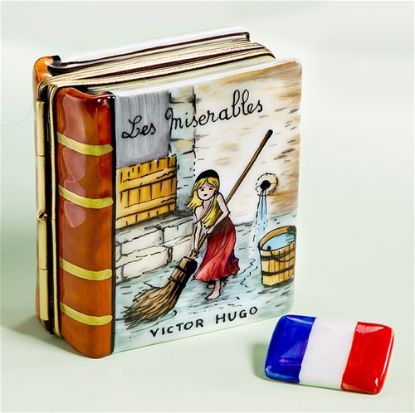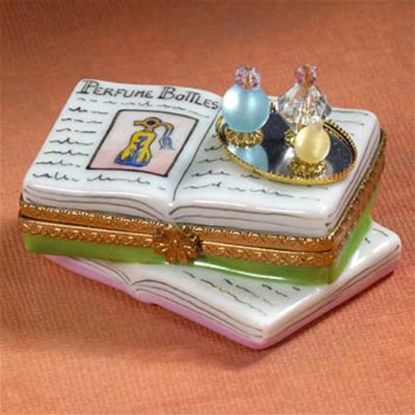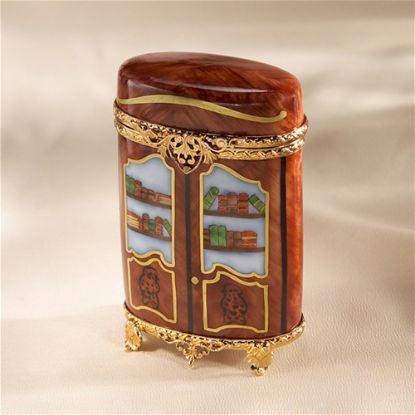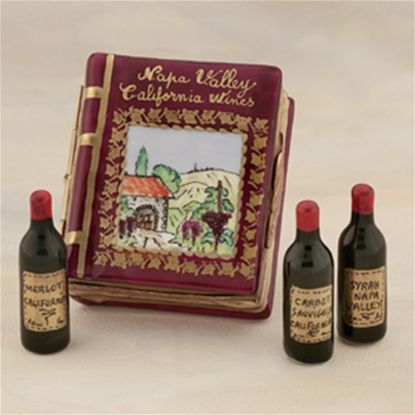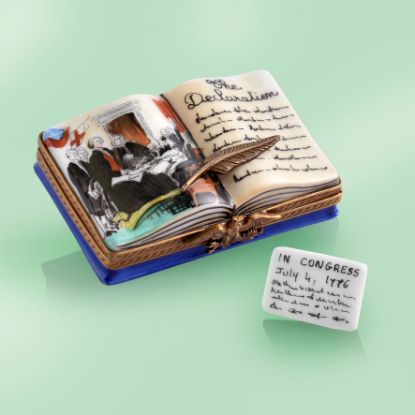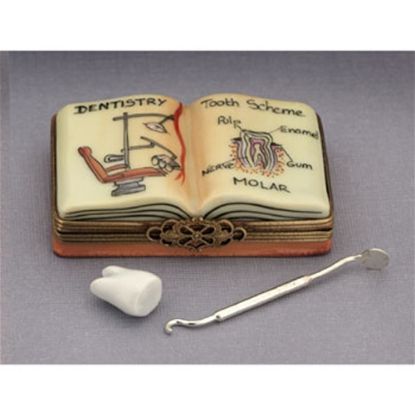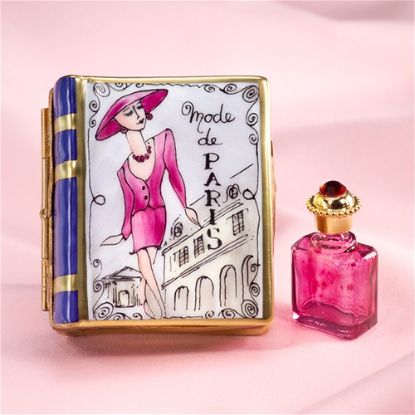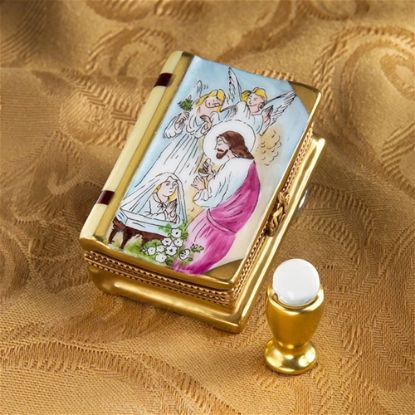Limoges Book Boxes
Books are integrated into our daily lives. They are used for telling stories, archiving history and sharing information about our world. Books have evolved over time from handwritten text to printed pages and now digital copies. No matter the readers preference, books remain timeless. From the 3rd millennium BC to the 7th century BC, clay tablets were used by the Mesopotamians to record history of the kings of Assyria, record legal contracts, create lists of assets and literature and myths. They also documented laws relating to the practice of medicine, penalties for failure and even early dentistry. The ancient Egyptians used papyrus as a type of paper to record their history, list of remedies and religious literature. China also has a long history of books in the form of thin, split and dried bamboo bound together with hemp, leather or silk called jian ce. Next came the woodblock printing which was a method of printing on cloth and later paper. The Limoges Chinese Zodiac Book Box has a painted scroll with Chinese zodiac symbols on an open book. The Limoges Medical Book Box has a painted diagram of lungs and a metal stethoscope attached to the top. The Limoges Dentist Book Box has a painted diagram of a molar tooth and includes a loose porcelain tooth and metal probe.
The Mayans and Aztecs recorded religious calendars, knowledge about the gods, society, economics and other histories in codices. Some were recorded on long strips of paper, agave fibers or animals hides that were folded and protected in wooden covers. The Romans used wax-coated tablets that they could write and erase on. These tablets were used for taking notes and for teaching. Societies from all over the world developed these early styles and educated younger generations. Parchment made from animal skins were used to replace papyrus. It proved easier to preserve text over time. The scroll was replaced by the codex which contained a collection of sheets attached at the back instead of a continuous roll. Between the 2nd and 4th centuries, the codex made it easier to find a precise text and to rest on a table while reading it. This style became the standard form and is still used today. Monasteries conserved religious texts and certain written works. They would copy and decorate manuscripts that have been preserved. Libraries were created to hold these copied texts. To help preserve them, chained libraries which consisted of books attached to cabinets with metal chains were made. You will find reference to this style in works such as Harry Potter and the Philosopher’s Stone by J.K. Rowling in which the Restricted Section of the Hogwarts Library has chained books. The Limoges Harry’s Book Box has a painted wizard cap on the cover with a wand and includes a loose pair of glasses. The Limoges Bible Box with Ten Commandments is painted with a gold cross on the front and includes a loose porcelain tablet.
In 1440, Johannes Gutenberg invented the printing press which was the start of the Printing Revolution. A single printing press of this era could produce 3,600 paged per workday. By the 1500’s, printing presses spread throughout Western Europe and had already produced over 20 million volumes. In the 19th century, Gutenberg’s hand operated press was replaced by the steam powered rotary press of the Industrial Revolution invented by Richard M. Hoe. This style press was capable of printing millions of copies in a single day.
In 1813, Jane Austen published the romantic novel, Pride and Prejudice. It centers on the relationship between the daughter of a country gentleman and a rich aristocratic landowner. Jane Austen was born during the Georgian era which saw the dawn of the Industrial revolution, the shift from Enlightenment to Romantic trends and the start of feminist and abolitionist concerns. The Bennets in this novel, like Jane Austen, are members of an educated upper middle class. They are one step lower than the landowners but are able to hang out socially. This novel depicts a society in which women have to behave in a certain way and if they deviate from the social norms, they will be a victim of ostracism. The theme of love versus class and reputation has made this novel the ultimate timeless love story. Pride and Prejudice remains at the top of the best-sellers list with over 20 million copies sold is the past 200 years. The Limoges Pride and Prejudice Book Box and Limoges Pride and Prejudice Heart Box has a detailed painting of Mr. Darcy and Elizabeth Bennet in the garden.
In 1862, Victor Hugo published the French historical novel, Les Miserables. This novel was such a success that it was quickly translated into many other languages. It is also one of the longest novels in European literature with about 1,500 pages in unabridged English editions and 1,900 pages in French. Les Miserables follows the social injustice of many characters that are unable to seek recompense. Hugo wanted everything written in this novel to have meaning. It is a tragedy in which infinity, like the length of the book, plays the lead and that the people play the supporting role. Hugo wanted to transform and rewrite history to include the unknown and to show how far history is fiction. The Limoges Cosette Les Miserables Book Box has a painted scene of a young Cosette sweeping in the Thenardiers’ Inn. The Limoges Les Miserables Book Box has a painted scene of the 1832 Rebellion. The Limoges Cosette from the Miserables Box is designed to look like the young Cosette in service holding a wash bucket.
In 1886, Sir Arthur Conan-Doyle wrote A study in Scarlet. It was the first of 4 novels and 56 short stories starring Sherlock Holmes. This fictional private detective was based on a forensic scientist, Dr. Joseph Bell. Conan-Doyle studied under him at Edinburgh University Medical School. Dr. Bell’s methods of diagnosing a patient’s disease was parallel to Sherlock Holmes methods of gathering evidence. Dr. Bell was charismatic and was also able to determine a patient’s occupation and other personal details by studying the appearance and mannerisms of that person. Sherlock Holmes was adapted into movies, tv series and theater. Popular parodies and pastiches have also been developed based on the Sherlock Holmes character. The televisions series, House, aired for 8 seasons and is known to be one of the quirkiest adaptions of Sherlock Holmes. Dr. Gregory House relied on psychology to solve his cases and refused to accept cases that he did not find interesting. He also had a drug addiction and his home address was apartment 221B. Another popular adaption series is Elementary which aired for 6 seasons featuring a disgraced Sherlock Holmes moving to present day Manhattan after rehab. His assigned sober companion, Dr. Joan Watson, seeks penance for losing a patient and together, they consult for NYPD to crack difficult cases. The Limoges Sherlock Holmes Book with Pipe Box, Limoges Sherlock Holmes Book with Cat Box, Limoges Sherlock Holmes and Dr Watson Box and the Limoges Sherlock Holmes Bag with Magnifier Box are great items for the inspiring detective or for those who enjoy mystery fictions!
In 1901, Beatrix Potter illustrated and published one of the best-selling children’s books of all time, The Tale of Peter Rabbit. The story centers on Peter Rabbit whose disobedience leads to trouble. The book combines humor, adventure and a moral lesson. It teaches young children about danger and that actions have consequences. Originally, Potter’s work was rejected by publishing companies so she released it herself in 1901. The original 42 black and white illustrations with small format was so popular that Frederick Warne & Co. agreed to publish it in 1902. This book inspired Potter to publish more than 20 additional stories featuring animals. The Limoges Peter Rabbit Book Box and Limoges Peter Rabbit in Blue with Carrot Box are sweet gifts for children of all ages!
In 1925, F. Scott Fitzgerald published The Great Gatsby. This story tells the tale of a self-made millionaire, Jay Gatsby, and his pursuit of a wealthy married young woman, Daisy Buchanan. The novel takes place in the 1920s when the economy experienced a rise after WWI and there was free-flowing illegal liquor. Gatsby’s illegal schemes for selling liquor during Prohibition is one enterprise in which he made his income. He believed by becoming rich, he would be able to win the heart of his old sweet heart, Daisy. The struggle and tension between new money and old money is represented in this book. Those who inherit wealth look down on those who established themselves from a poor upbringing. The Great Gatsby is chosen for many high school curriculums for its symbolism, motifs and themes. The Limoges Great Gatsby Book with Cat Box is decorated with thoughtful details such as the 1920s classic car clasp to the loose porcelain tux shirt. This item would be perfect for the roaring twenties fan!
In 1943, Antoine de Saint-Exupery published the fable and modern classic, The Little Prince. This story tells the tale of a child who travels the universe and gains knowledge from different inhabitants he finds on various planets. This book portrays adults as being narrow-minded. Children have a willingness to explore the world around them and in return gain wisdom. Antoine de Saint-Exupery, like the narrator, was a pilot who experienced a plane crash in a desert. Critics viewed the narrator and little prince in the book as expressions of different aspects of the author himself. The Little Prince was translated into over 250 languages and has been adapted into operas, ballets, films and theater. The Limoges Little Prince Boxes have painted scenes and figures from the book’s illustrations. These items would be great gifts for the little adventurer!
In 1945, George Orwell published the political fable, Animal Farm. The story tells the tale of a group of barnyard animals who overthrow their exploitative human masters and set up their own egalitarian society. The pigs who are the animal’s power-loving leaders subvert the revolution and form a dictatorship more oppressive than their former human masters. This novel is based on the events of Russia’s Bolshevik revolution and the betrayal of the cause by Joseph Stalin. Animal Farm has become an important book and is part of many educational curriculums. It shows the reader the potential dangers of good intentions. Even revolutions born from good intentions can mislead those they are meant to serve. The Limoges Animal Farm Book with Cat Box is a classically painted bookshelf with a pig clasp and loose porcelain field mouse.




